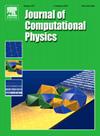On a two-phase incompressible diffuse interface fluid model with curvature-dependent mobility
IF 3.8
2区 物理与天体物理
Q2 COMPUTER SCIENCE, INTERDISCIPLINARY APPLICATIONS
引用次数: 0
Abstract
A mass-conserved diffuse interface two-phase fluid model is developed to capture more fluid details without introducing a large number of meshes. The original Cahn–Hilliard (CH) model satisfies the energy dissipation law by minimizing the total length of the interface. Although the total mass is conserved, the original CH dynamics will lead to the local mass loss of small fluids. The traditional approaches for fixing the local mass loss are to increase the number of mesh grids and to utilize the adaptive mesh refinement technique. However, these approaches either require significant computational time or increase the difficulty in numerical implementation. To reduce the local mass loss with the same computational resources, we propose a curvature-dependent mobility. In the regions with large curvature, this mobility minimizes the shrinking dynamics of the interface in the diffuse interface. In regions with small curvature, this mobility only minimizes the interfacial dynamics on the fluid interface. Since the new mobility is always nonnegative, the proposed model still satisfies the total mass conservation and energy dissipation property. Compared with the original CH model, the present model has better capability for local mass conservation. For two-phase fluid flow problems where the density and viscosity ratios are equal, we develop a linear, second-order accurate, and energy-stable time-marching scheme. The leap-frog-type method is adopted to discretize the proposed CH model in time and the simplified auxiliary variable method with correction is used to discretize the incompressible Navier–Stokes equations in time. We name this new scheme the leap-frog-auxiliary-variable (LFAV) method. For an arbitrary time step, we analytically prove the time-discretized energy stability. In each time step, we only need to separately solve several parabolic equations for the velocities, a Poisson equation for pressure, and a parabolic equation with variable coefficients for the phase-field variable. Several numerical experiments have been performed to validate the accuracy, stability, and capability of interface capturing of the developed model and method. The proposed model is further extended to simulate a dam break in three-dimensional space. The numerical results show that this new model has good potential in capturing large fluid deformation and small splashing liquids.
求助全文
约1分钟内获得全文
求助全文
来源期刊

Journal of Computational Physics
物理-计算机:跨学科应用
CiteScore
7.60
自引率
14.60%
发文量
763
审稿时长
5.8 months
期刊介绍:
Journal of Computational Physics thoroughly treats the computational aspects of physical problems, presenting techniques for the numerical solution of mathematical equations arising in all areas of physics. The journal seeks to emphasize methods that cross disciplinary boundaries.
The Journal of Computational Physics also publishes short notes of 4 pages or less (including figures, tables, and references but excluding title pages). Letters to the Editor commenting on articles already published in this Journal will also be considered. Neither notes nor letters should have an abstract.
 求助内容:
求助内容: 应助结果提醒方式:
应助结果提醒方式:


